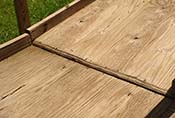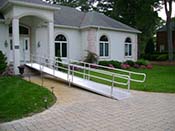You have no items in your shopping cart.
Wooden Wheelchair Ramps
Thinking of Building a wooden wheelchair ramp?
- Lumber prices are near an all time high.
- Wood requires constant maintenance years to come.
- Wooden ramps probably don't meet residential ramp code.
Bumpy Transitions

Handrails with Splinters

Not Ramp Code Compliant

Advantages of Aluminum Wheelchair Ramps over Building Wooden Wheelchair Ramps
| Pathway Wheelchair Ramps | Wooden Handicapped Ramps |
|---|---|
| ✓ Durable, Long-lasting Solution | |
| ✓ Will not rot or rust | |
| ✓ Virtually Maintenance Free | |
| ✓ East to install with minimal tools | |
| ✓ Typically no building permits required | |
| ✓ Easy to move, reconfigure or expand | |
| ✓ Take it with you if you move! | |
| ✓ Captured Fasteners, nothing protruding to catch yourself on | |
| ✓ Meets most building codes | |
| ✓ Stylish, Modern Design | |
| ✓ Typically installs in 1-2 hours or less | |
| ✓ No Anchoring into Concrete Required | |
| ✓ Smooth transitions on and off the ramp | |
| ✓ Made of Environmentally Friendly Aluminum - Completely Recyclable | |
| ✓ Has resale value if no longer needed |

